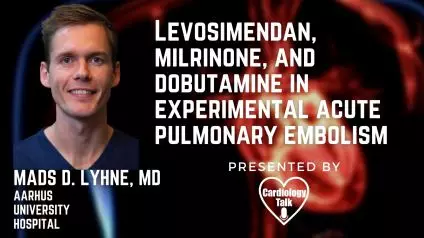Mads D. Lyhne, MD @MadsDam_MD @AUHdk #AcutePulmanaryEmbolism #Cardiology #Research Experimental Acute Pulmonary Embolism
Mads D. Lyhne, MD from the Department of Cardiology, Aarhus University Hospital, Aarhus, Denmark speaks about Levosimendan, milrinone, and dobutamine in experimental acute pulmonary embolism.
Link to Abstract:
https://journals.sagepub.com/doi/10.1177/20458940211022977
Abstract-
Acute pulmonary embolism is a common and possibly deadly disease in emergency care. Right ventricular failure is the cause of mortality, which is caused by an increase in right ventricular afterload caused by both pulmonary vascular obstruction and vasoconstriction. Inodilators are intriguing medicines of choice because they have the potential to enhance right ventricular performance and reduce afterload. In acute pulmonary embolism, we wanted to see how three therapeutically relevant inodilators, levosimendan, milrinone, and dobutamine, affected the cardiovascular system. We used 18 female pigs in randomized, blinded animal research. Animals were given a substantial autologous pulmonary embolism and were randomized to escalating dosages of each inodilator until their baseline mean pulmonary arterial pressure was doubled. Biventricular pressure-volume loop recordings, right heart catheterization, and blood gas analysis were used to assess the effects. Inducing pulmonary embolism resulted in a rise in right ventricular afterload and pulmonary pressure (p 0.05), resulting in right ventricular dysfunction. Levosimendan and milrinone improved right ventricular function and cardiac output (p 0.05) without increasing right ventricular mechanical work and showed beneficial hemodynamic profiles by lowering right ventricular pressures and volume (p 0.001) and improving right ventricular function and cardiac output (p 0.001). Dobutamine improved right ventricular function and pressure (p 0.01), but at the expense of increased mechanical effort at the highest dosages, indicating an unfavorable hemodynamic profile. Levosimendan and milrinone decreased right ventricular afterload and enhanced right ventricular function in a porcine model of acute pulmonary embolism, but dobutamine raised right ventricular afterload and right ventricular mechanical effort at higher dosages. The research aims to evaluate inodilators in patients with acute pulmonary embolism and right ventricular failure in the clinic.




